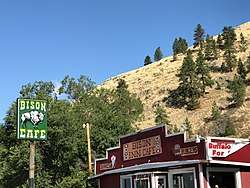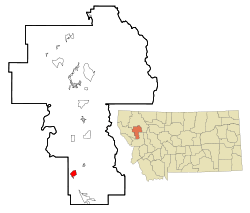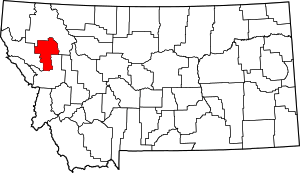Ravalli, Montana
Ravalli (Salish: sk̓ʷɫólqʷe, sk̓ʷɫʔó[1]) is an unincorporated community and census-designated place (CDP) in Lake County, Montana, United States. The population was 76 at the 2010 census,[2] down from 119 at the 2000 census. At one time Charlie Allard, the country's leading expert on breeding bison, owned the country's largest herd of buffalo in Ravalli.[3]
Ravalli, Montana | |
|---|---|
 | |
 Location of Ravalli, Montana | |
| Coordinates: 47°16′25″N 114°10′42″W | |
| Country | United States |
| State | Montana |
| County | Lake |
| Area | |
| • Total | 2.64 sq mi (6.84 km2) |
| • Land | 2.63 sq mi (6.81 km2) |
| • Water | 0.01 sq mi (0.03 km2) |
| Elevation | 2,717 ft (828 m) |
| Population (2010) | |
| • Total | 76 |
| • Density | 29/sq mi (11.2/km2) |
| Time zone | UTC-7 (Mountain (MST)) |
| • Summer (DST) | UTC-6 (MDT) |
| ZIP code | 59863 |
| Area code(s) | 406 |
| FIPS code | 30-61075 |
| GNIS feature ID | 0775601 |
History
A post office called Ravalli was established in 1887 and remained in operation until 1983.[4] The community was named for Antonio Ravalli, a Jesuit missionary to the Indians.[5]
Geography

Ravalli is located in southern Lake County at 47°16′25″N 114°10′42″W (47.273710, -114.178334),[6] at the junction of U.S. Route 93 and Montana Highway 200, at the bottom of a big hill near the National Bison Range. US 93 leads north 33 miles (53 km) to Polson, the Lake county seat, and south 36 miles (58 km) to Missoula. MT 200 leads west 7 miles (11 km) to Dixon.
According to the United States Census Bureau, the CDP has a total area of 2.6 square miles (6.8 km2), of which 0.01 square miles (0.03 km2), or 0.42%, are water.[7] The community is in the valley of the Jocko River, which flows northwest to the Flathead River at Dixon.
Climate
This climatic region is typified by large seasonal temperature differences, with warm to hot (and often humid) summers and cold (sometimes severely cold) winters. According to the Köppen Climate Classification system, Ravalli has a humid continental climate, abbreviated "Dfb" on climate maps.[8]
Demographics
As of the census[9] of 2000, there were 119 people, 48 households, and 30 families residing in the CDP. The population density was 44.8 people per square mile (17.3/km2). There were 52 housing units at an average density of 19.6 per square mile (7.6/km2). The racial makeup of the CDP was 71.43% White, 27.73% Native American, and 0.84% from two or more races. Hispanic or Latino of any race were 6.72% of the population.
There were 48 households, out of which 33.3% had children under the age of 18 living with them, 41.7% were married couples living together, 6.3% had a female householder with no husband present, and 37.5% were non-families. 25.0% of all households were made up of individuals, and 10.4% had someone living alone who was 65 years of age or older. The average household size was 2.48 and the average family size was 3.03.
In the CDP, the population was spread out, with 27.7% under the age of 18, 7.6% from 18 to 24, 33.6% from 25 to 44, 20.2% from 45 to 64, and 10.9% who were 65 years of age or older. The median age was 34 years. For every 100 females, there were 98.3 males. For every 100 females age 18 and over, there were 100.0 males.
The median income for a household in the CDP was $26,750, and the median income for a family was $29,688. Males had a median income of $4,750 versus $32,708 for females. The per capita income for the CDP was $14,094. There were 16.0% of families and 24.0% of the population living below the poverty line, including no under eighteens and none of those over 64.
References
- Tachini, Pete (2010). Seliš nyoʻnuntn, Medicine for the Salish language : English to Salish translation dictionary (2nd ed.). Pablo, MT: Salish Kootenai College Press. p. 487. ISBN 9781934594063.
- "Total Population: 2010 Census DEC Summary File 1 (P1), Ravalli CDP, Montana". data.census.gov. U.S. Census Bureau. Retrieved April 21, 2020.
- The Strand Magazine. 1901. p. 410.
- "Lake County". Jim Forte Postal History. Retrieved 27 October 2015.
- Winser, Henry Jacob; Riley, William C. (1897). The Official Northern Pacific Railway Guide: For the Use of Tourists and Travelers Over the Lines of the Northern Pacific Railway and Its Branches. Northern Pacific Railway. p. 198.
- "US Gazetteer files: 2010, 2000, and 1990". United States Census Bureau. 2011-02-12. Retrieved 2011-04-23.
- "U.S. Gazetteer Files: 2019: Places: Montana". U.S. Census Bureau Geography Division. Retrieved April 21, 2020.
- Climate Summary for Ravalli, Montana
- "U.S. Census website". United States Census Bureau. Retrieved 2008-01-31.
